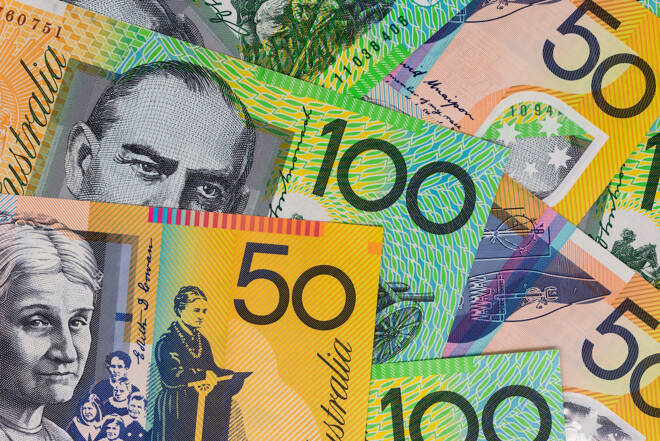Advertisement
Advertisement
AUD/USD and NZD/USD Fundamental Analysis: Fed Chatter in Focus
By:
It is a relatively busy day for the AUD/USD, with business and consumer confidence figures in focus ahead of more Fed chatter later today.
Highlights
- The AUD/USD and the NZD/USD recovered heavy losses on Monday, with Fed chatter delivering support.
- This morning, Australian business and consumer confidence figures will draw interest.
- However, the economic indicators are unlikely to have a material influence on the RBA, with a pickup in consumer confidence needing to translate into increased consumption to affect the RBA policy plans.
It is a relatively busy start to the day for the AUD/USD. The NAB Business Confidence and Westpac Consumer Confidence survey from Australia are out this morning. With the RBA hiking rates, both reports will likely impact the AUD/USD.
Economists forecast the NAB Business Confidence Index to fall from -4 to -6 and the Westpac Consumer Confidence Index to increase from 79.2 to 80.4. While a pickup in consumer confidence would signal higher consumption, the RBA may wait for the consumer spending and inflation numbers to consider next steps.
There are no economic indicators from New Zealand to influence the NZD/USD, leaving market risk sentiment to move the dial.
The European Session
It is a busy day ahead on the European economic calendar. Finalized German inflation numbers and ZEW Economic Sentiment will move the dial. Economists forecast the German ZEW Economic Sentiment to fall from -8.5 to -10.5 and the Eurozone ZEW Economic Sentiment Indicator to fall from -10 to -17.
Barring revisions to the German CPI numbers, the German ZEW Economic Sentiment will likely have more impact.
With the economic calendar on the busy side, ECB commentary will also need consideration. However, no ECB members are on the calendar to speak, leaving chatter with the media to move the dial.
The US Session
It is a quiet day on the US economic calendar, with no US economic indicators to provide direction. The quiet economic calendar will leave FOMC member commentary in focus, with FOMC member Bullard on the calendar to speak today.
FOMC members Barr, Bostic, and Daly weighed on the dollar, announcing the Fed monetary policy tightening cycle is nearing its end.
FOMC Member Mary Daly reportedly favored two further rate hikes this year but added,
“While the risks of doing too little are still greater than those of overdoing it on rate hikes, the two sides are getting into better balance as the Fed nears the last part of its hiking cycle.”
FOMC member Michael Barr noted that he thinks the Fed is close, with Raphael Bostic erring on the side of patience.
According to the CME FedWatch Tool, the probability of a 25-basis point July Fed rate hike was 92.4% versus 93.0% on Friday. Significantly, the chances of the Fed lifting rates to 5.75% in September stood at 23.1%, down from 24.2% on Friday.
AUD/USD Price Action
Daily Chart
The Daily Chart showed the AUD/USD remained below the psychological $0.67 resistance level and the $0.6750 – $0.6770 resistance band.
Notably, the AUD/USD fell below the 50-day EMA ($0.66860) and remained below the 200-day EMA ($0.67471), signaling bearish momentum over the near and longer-term time horizons.
The 50-day EMA eased back from the 200-day EMA and reflected bearish momentum following the choppy Monday session.
Looking at the 14-Daily RSI, the 49.21 reading signals a moderately bearish trend and aligns with the 50-day EMA. The bearish indicators bring the $0.6615 – $0.6600 support band into view. However, an Aussie dollar move through the 50-day EMA ($0.66860) would give the bulls a run at the 200-day EMA ($0.67471) and the lower level of the $0.6750 – $0.6770 resistance band.
4-Hourly Chart
Looking at the 4-Hourly Chart, the AUD/USD faces strong resistance at the $0.67 psychological level. After the Monday session, the AUD/USD sits above the 50-day EMA ($0.66655) while sitting below the 200-day EMA ($0.66831). The EMAs sent mixed signals.
Significantly, the 50-day EMA narrowed to the 200-day EMA, signaling a move through the 200-day EMA to target the $0.6750 – $0.6770 resistance band.
However, the AUD/USD must hold above the 50-day EMA to retarget $0.67. A fall through the 50-day EMA ($0.66655) would bring the upper level of the $0.6615 – $0.6600 support band into view.
Looking at the RSI indicator, the 14-4H RSI reading of 54.33 indicates a moderately bullish stance, with buying pressure outweighing selling pressure. The RSI is aligned with EMAs and supports a run at the lower level of the $0.6750 – $0.6770 resistance band.
NZD/USD Price Action
Daily Chart
The Daily Chart showed the NZD/USD avoided a fall through the $0.6200 psychological level despite a choppy Monday session. Significantly, the EMAs send mixed bearish signals. The Kiwi dollar sat above the 50-day EMA ($0.61700) while below the 200-day EMA ($0.62210).
Notably, the 50-day EMA narrowed on the 200-day EMA, reflecting bullish momentum over the near term but bearish over the longer-term time horizon.
Looking at the 14-Daily RSI, the 56.60 reading signals a moderately bullish trend, supporting a run at the 200-day EMA ($0.62210) and the lower level of the $0.6234 – $0.6250 resistance band.
4-Hourly Chart
Looking at the 4-Hourly Chart, the NZD/USD faces strong resistance at the $0.62 psychological level. After the bullish Monday session, the NZD/USD sits above the 50-day ($0.61712) and 200-day ($0.61604) EMAs, supporting a run at the $0.6234 – $0.6250 resistance band.
Notably, the 50-day EMA pulled further away from the 200-day EMA, a bullish signal.
The 14-4H RSI reading of 58.52 indicates a bullish trend, with buying pressure outweighing selling pressure. Significantly, the 14-4H RSI aligns with the EMAs and signals a run at the $0.6234 – $0.6250 resistance band.
About the Author
Bob Masonauthor
With over 28 years of experience in the financial industry, Bob has worked with various global rating agencies and multinational banks. Currently he is covering currencies, commodities, alternative asset classes and global equities, focusing mostly on European and Asian markets.
Advertisement
